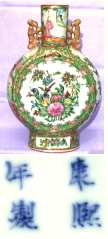
This page is only one of many thousands of Gotheborg.com Help and Information Pages, offering specialized knowledge on Chinese and Japanese Porcelain, including a Glossary, Q&A, Chinese and Japanese Porcelain Marks, Chinese Porcelain Exhibition and Excavation reports etc. For personal help and far more information, join our Discussion Board or use 'Ask a Question' for quick email consultations. For full text and better navigation, use a full-screen device rather than a mobile phone, that offers only limited content.
In reading your very interesting articles I have come to the conclusion that all Chinese blue & white porcelain have marks. Are there any cases where there are no marks and yet the piece would be an authentic antique and of some value?
As a rule no Chinese export porcelain from the 18th century have any marks. Most 19th century export pieces also lacks marks.
All genuine marks are only to be found on porcelain made for the reigning Chinese Emperor.
 Most "fake" marks are found on Chinese porcelain intended for the Chinese home market and are most often added to match the general design of the piece and of course to add some value.
Most "fake" marks are found on Chinese porcelain intended for the Chinese home market and are most often added to match the general design of the piece and of course to add some value.
During the 19th and 20th century a great deal of this "Chinese taste" porcelain was exported and can have all kinds of marks.
Most common are seal marks in a red square. Second most common are four character marks in blue and white, such as the enclosed four character Kangxi mark, The piece this mark is found on is a Chinese Porcelain Pilgrims' bottle with a late 19th century enameled decoration called "Rose Mandarin" in the US, and in Europe commonly only called "Canton". The vase is from the Tongzhi 1862 - 1874 period and this marking is quite common during this period.
I hope this helps.
Jan-Erik Nilsson